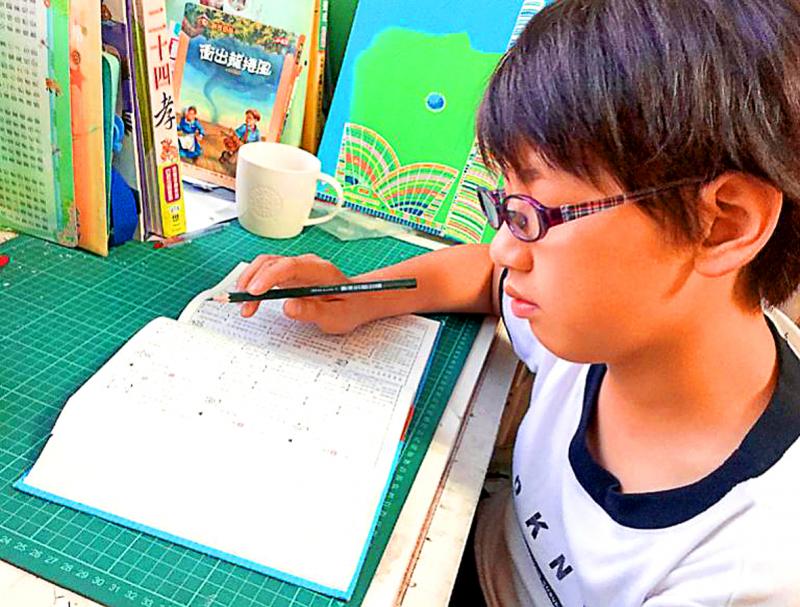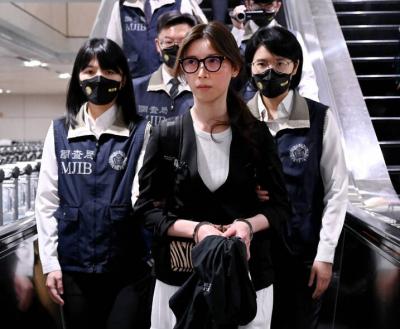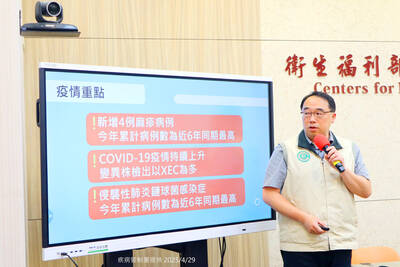The share of elementary-school students with poor vision has grown over the past two academic years after an eight-year decline, the Ministry of Health and Welfare has said.
Ministry data showed that 44.6 percent of elementary-school students last year had poor vision, defined as having visual acuity below 0.9 in at least one eye.
The share was 44.35 percent in the 2019-2020 academic year, which ended a decline since 2011-2012, when 50.01 percent of elementary-school students had poor vision.

Photo: Taipei Times, file photo
Kaohsiung Chang Gung Memorial Hospital ophthalmologist Wu Pei-chang (吳佩昌), who leads the school children’s vision health program at the Health Promotion Administration (HPA) and the K-12 Education Administration, said lifestyle changes during the COVID-19 pandemic are the major cause of the rise.
Due to the pandemic, many schools transitioned to distance learning, requiring students to take online classes, he said, adding that many students also spent more time online for entertainment than before the pandemic emerged in early 2020.
Similar problems have been reported in the US, Singapore and China, where one province recorded that 25 percent of elementary-school students were nearsighted after a lockdown, up from 5 percent before the COVID-19 measure was implemented.
The situation in Taiwan is not as severe as in other countries, but should be taken seriously, he said.
He said students should spend more time outdoors during the summer vacation and get out of the classrooms every interval after the new semester starts.
The chance of becoming nearsighted halves if one spends at least 11 hours outdoors per week, which can also prevent other eye conditions, he said.
Meanwhile, the share of nearsighted students increases as age increases, with 28.13 percent of first-graders last year having poor vision, compared with 77.56 percent of ninth-graders, ministry data showed.
The share of nearsighted students in Taiwan has surpassed that of Japan, the data showed.
In Taiwan, 26.2 percent of first-graders and 82.4 percent of twelfth-graders last year had poor vision, while in Japan, 24.2 percent of first-graders and 64.4 percent of twelfth-graders had poor vision, it showed.
The margin between the two countries spreading from about 2 percentage points among first-graders to more than 18 percentage points among twelfth-graders showed that Taiwan should take the issue more seriously, the HPA said.
Tri-Service General Hospital Ophthalmology Department director Lu Da-wen (呂大文) said that people with a visual acuity of minus-5 or lower are considered heavily nearsighted.
The condition can lead to early-onset cataracts, macular degeneration, glaucoma and retinal detachment, Lu said.
HPA Director-General Wu Chao-chun (吳昭軍) said that measures should be taken to protect the eyesight of children of all ages, including vision and dilated fundus exams once or twice a year from age three or four.
Light farsightedness is normal and desirable among small children, Wu said, likening it to “savings in their vision bank.”
Preschool children should have visual acuity of 1 to 2, kindergarteners should have an acuity of 1.5 to 2, first and second-graders should have an acuity of 1 and third to six-graders should have at least 0.5, he said, adding that with these “savings,” children can prevent or delay the onset of nearsightedness.
Wearing glasses is a corrective measure, but medical treatment is needed to control the prescription from increasing, he said.

A fugitive in a suspected cosmetic surgery fraud case today returned to Taiwan from Canada, after being wanted for six years. Internet celebrity Su Chen-tuan (蘇陳端), known as Lady Nai Nai (貴婦奈奈), and her former boyfriend, plastic surgeon Paul Huang (黃博健), allegedly defrauded clients and friends of about NT$1 billion (US$30.66 million). Su was put on a wanted list in 2019 when she lived in Toronto, Canada, after failing to respond to subpoenas and arrest warrants from the Taipei District Prosecutors’ Office. Su arrived at Taiwan Taoyuan International Airport at 5am today on an EVA Air flight accompanied by a

A 79-year-old woman died today after being struck by a train at a level crossing in Taoyuan, police said. The woman, identified by her surname Wang (王), crossed the tracks even though the barriers were down in Jhongli District’s (中壢) Neili (內壢) area, the Taoyuan Branch of the Railway Police Bureau said. Surveillance footage showed that the railway barriers were lowered when Wang entered the crossing, but why she ventured onto the track remains under investigation, the police said. Police said they received a report of an incident at 6:41am involving local train No. 2133 that was heading from Keelung to Chiayi City. Investigators

The Keelung District Prosecutors’ Office today requested that a court detain three individuals, including Keelung Department of Civil Affairs Director Chang Yuan-hsiang (張淵翔), in connection with an investigation into forged signatures used in recall campaigns. Chang is suspected of accessing a household registration system to assist with recall campaigns targeting Democratic Progressive Party (DPP) city councilors Cheng Wen-ting (鄭文婷) and Jiho Chang (張之豪), prosecutors said. Prosecutors yesterday directed investigators to search six locations, including the Chinese Nationalist Party’s (KMT) Keelung office and the residences of several recall campaign leaders. The recall campaign leaders, including Chi Wen-chuan (紀文荃), Yu Cheng-i (游正義) and Hsu Shao-yeh

COVID-19 infections have climbed for three consecutive weeks and are likely to reach another peak between next month and June, the Centers for Disease Control (CDC) said yesterday. Weekly hospital visits for the disease increased by 19 percent from the previous week, CDC Epidemic Intelligence Center Director Guo Hung-wei (郭宏偉) said. From Tuesday last week to yesterday, 21 cases of severe COVID-19 and seven deaths were confirmed, and from Sept. 1 last year to yesterday, there were 600 cases and 129 deaths, he said. From Oct. 1 last year to yesterday, 95.9 percent of the severe cases and 96.7 percent of the deaths